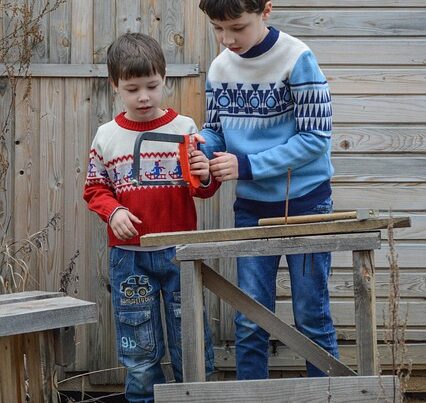
Origins of attachment theory
John Bowlby created attachment theory in the 1950s and published articles on it for twenty years. He drew on concepts from several areas in psychology. For example, Freud’s ideas of the mother/child relationship and its impact on the unconscious. Lorenz’s ideas on imprinting in birds contributed to Bowlby’s thinking on the role of instincts in the “bonding” relationship. Darwin’s theory of evolution supported his idea that an infant’s innate propensity to form an attachment is more adaptive. Piaget and Robertson, with their work on development stages, contributed as well.
Bowlby also incorporated concepts from control systems theory, viewing attachment quality as a regulator of a child’s behavior. From cognitive psychology, he developed the idea of an “internal working model” that the child develops about self and others. In his clinical work, he noticed the effects of foster care and institutionalization on children and sought a theoretical framework to explain his observations. As the chart in the image above shows, his was very much of a top down, cognitive approach.
Mary Ainsworth’s “strange situation”
Empirical support for Bowlby’s theory comes from Mary Ainsworth’s “Strange Situation” studies. She proposed four categories of attachment styles. These broad categories have be used for years and are still popular labels.
- Secure. With this style, toddlers are more comfortable exploring their surroundings. Mothers can quickly comfort these children.
- Anxious-ambivalent. Separation from their month will upset these children. Comforting them can take longer. They can cling, but not calm down.
- Anxious-avoidant. These children can ignore or avoid the caregiver and show little emotion when separated. They appear both distant and self reliant.
- Disorganized attachment. Ainsworth added this category because the behavior just didn’t fit into the other categories.
Systems viewpoint on attachment
From a systems viewpoint, attachment theory does not address several issues. First, it is an individual model, with a focus on the primary caregiver’s behaviour. (My mother didn’t love me enough, so my relationships are messed up). It doesn’t address the effects of the caregivers’ “system”. It also doesn’t address the role of anxiety in the system. Anxiety can manifest as not enough attention, but it can also manifest as an anxious focus with too much attention on the child. Anxious driven attention can distort the quality of the relationship. A child can notice anxiety in their parents and in the system and be reactive to that. A more anxious child might easily display a non-secure style. (I’m condensing a two-day conference into a paragraph!)
Emotionally autonomous, not emotionally attached
According to Bowen Theory, development is about becoming more emotionally autonomous or differentiated. More differentiated individuals can develop their own goals based on their own thinking and values. They have more ability to hold on to their principles, even if it means being criticized. Being more differentiated, they aren’t (as) threatened by what others might think or feel. Thus, they can form very meaningful relationships. The level of parental affection does not limit the relationship quality of these individuals.
An alternative to attachment theory
Welch and Ludwig have a new way to think about attachment. They propose that attachment is based on the development of the adaptive Autonomic Socio Emotional Reflex (ASR). This is a bottom up, physiologically based approach to the concept of attachment. They posit that during a healthy gestation and birth, conditional learning for the mother and infant takes place. They both learn to orient and approach to each other, automatically. It is relationship based. It is also adaptive since the mother and infant both need to orient to and approach the other to minimize distress for both. Welch named this regulating influence in her “calming cycle theory”. She also developed an intervention call Family Nurture Intervention that can create an adaptive ASR using emotional connection.
Observer first, theory second
The ASR and Calming Cycle Theory are based on over ten years of clinical work and studies. Researchers observed that creating an adaptive ASR is possible even with a premature birth. Welch developed the Family Nurture Intervention in order to improve the quality of the mother infant emotional connection. Later, she developed the Welch Emotional Connection Scale (WECS) in to objectively assess the quality of the emotional connection. The measures include: eye contact or gaze aversion, physical attraction or avoidance, vocal cooing or distress, and reciprocal responsiveness. With this model, Welch developed her theory in order to explain her observations. This is the same approach Dr. Bowen used in his work. If the theory didn’t fit the observations, the theory was wrong and needed to be adjusted.
The emotion connection emotional contact continuum
Welch’s concept of emotional connection exists along a continuum of maladaptive to adaptive. An observer can quickly “score” how adaptive or not the connection is using the measure in the WECS. The quality of this connection sets a foundation for the quality of emotional regulation and social interactions of the child. Being on a continuum, there are no categories that are artificially created and labeled. The mother and child aren’t broken or “normal”, they are just at a point on a continuum as an outcome of natural processes.
There is more research being done using the Family Nurture Intervention with very positive results. Biology appears to be telling us that Welch’s “emotional connection” is the first stage of being in a relationship. It is an immature relationship and highly fused. I also believe that biology is tells us what an adaptive, mature relationship looks like. In fact, I think it would look like a mature version of WECS!
It appears that our relationship self develops along a continuum of emotional connection (fusion) to good emotional contact (differentiated). And I’m still working to move along the continuum towards being more differentiated. At least I know I’m moving in the adaptive direction.
Thank you for your interest in family systems.
Comments are welcome: dave.galloway@livingsystems.ca
This post was inspired by this article: 6 week intervention.
Read more about Bowen Theory here
This is brief overview of Bowen Theory in Psychology Today: Bowen Theory.


